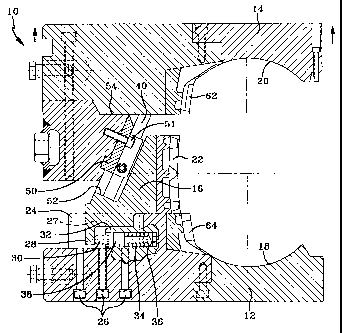Some of the information on this Web page has been provided by external sources. The Government of Canada is not responsible for the accuracy, reliability or currency of the information supplied by external sources. Users wishing to rely upon this information should consult directly with the source of the information. Content provided by external sources is not subject to official languages, privacy and accessibility requirements.
Any discrepancies in the text and image of the Claims and Abstract are due to differing posting times. Text of the Claims and Abstract are posted:
| (12) Patent: | (11) CA 2385188 |
|---|---|
| (54) English Title: | SEGMENTED TIRE MOLD |
| (54) French Title: | MOULE A PNEUMATIQUES SEGMENTE |
| Status: | Expired and beyond the Period of Reversal |
| (51) International Patent Classification (IPC): |
|
|---|---|
| (72) Inventors : |
|
| (73) Owners : |
|
| (71) Applicants : |
|
| (74) Agent: | MARKS & CLERK |
| (74) Associate agent: | |
| (45) Issued: | 2008-12-09 |
| (86) PCT Filing Date: | 1999-10-01 |
| (87) Open to Public Inspection: | 2001-04-12 |
| Examination requested: | 2004-05-20 |
| Availability of licence: | N/A |
| Dedicated to the Public: | N/A |
| (25) Language of filing: | English |
| Patent Cooperation Treaty (PCT): | Yes |
|---|---|
| (86) PCT Filing Number: | PCT/US1999/022799 |
| (87) International Publication Number: | WO 2001024987 |
| (85) National Entry: | 2002-03-18 |
| (30) Application Priority Data: | None |
|---|
A segmented tire mold having radially movable circumferentially spaced sliding
center segments activated by sliding
connections between an upper mold half and the segments in response to opening
and closing of the mold.
L'invention concerne un moule à pneumatiques segmenté, comportant des segments centraux coulissants espacés sur la circonférence et radialement mobiles, que l'on active par des connexions coulissantes entre une moitié de moule supérieure et les segments, en réponse à l'ouverture et à la fermeture du moule.
Note: Claims are shown in the official language in which they were submitted.
Note: Descriptions are shown in the official language in which they were submitted.

2024-08-01:As part of the Next Generation Patents (NGP) transition, the Canadian Patents Database (CPD) now contains a more detailed Event History, which replicates the Event Log of our new back-office solution.
Please note that "Inactive:" events refers to events no longer in use in our new back-office solution.
For a clearer understanding of the status of the application/patent presented on this page, the site Disclaimer , as well as the definitions for Patent , Event History , Maintenance Fee and Payment History should be consulted.
| Description | Date |
|---|---|
| Time Limit for Reversal Expired | 2010-10-01 |
| Letter Sent | 2009-10-01 |
| Grant by Issuance | 2008-12-09 |
| Inactive: Cover page published | 2008-12-08 |
| Inactive: Final fee received | 2008-07-25 |
| Pre-grant | 2008-07-25 |
| Notice of Allowance is Issued | 2008-02-04 |
| Letter Sent | 2008-02-04 |
| Notice of Allowance is Issued | 2008-02-04 |
| Inactive: Approved for allowance (AFA) | 2007-10-26 |
| Amendment Received - Voluntary Amendment | 2007-04-20 |
| Inactive: S.30(2) Rules - Examiner requisition | 2006-10-30 |
| Inactive: IPC from MCD | 2006-03-12 |
| Letter Sent | 2004-06-02 |
| Request for Examination Requirements Determined Compliant | 2004-05-20 |
| All Requirements for Examination Determined Compliant | 2004-05-20 |
| Request for Examination Received | 2004-05-20 |
| Inactive: Cover page published | 2002-09-11 |
| Inactive: Notice - National entry - No RFE | 2002-09-06 |
| Letter Sent | 2002-09-06 |
| Letter Sent | 2002-09-06 |
| Application Received - PCT | 2002-06-17 |
| National Entry Requirements Determined Compliant | 2002-03-18 |
| Application Published (Open to Public Inspection) | 2001-04-12 |
There is no abandonment history.
The last payment was received on 2008-09-19
Note : If the full payment has not been received on or before the date indicated, a further fee may be required which may be one of the following
Please refer to the CIPO Patent Fees web page to see all current fee amounts.
| Fee Type | Anniversary Year | Due Date | Paid Date |
|---|---|---|---|
| MF (application, 2nd anniv.) - standard | 02 | 2001-10-01 | 2002-03-18 |
| Registration of a document | 2002-03-18 | ||
| Basic national fee - standard | 2002-03-18 | ||
| MF (application, 3rd anniv.) - standard | 03 | 2002-10-01 | 2002-03-18 |
| MF (application, 4th anniv.) - standard | 04 | 2003-10-01 | 2003-09-25 |
| Request for examination - standard | 2004-05-20 | ||
| MF (application, 5th anniv.) - standard | 05 | 2004-10-01 | 2004-09-23 |
| MF (application, 6th anniv.) - standard | 06 | 2005-10-03 | 2005-09-26 |
| MF (application, 7th anniv.) - standard | 07 | 2006-10-02 | 2006-09-20 |
| MF (application, 8th anniv.) - standard | 08 | 2007-10-01 | 2007-10-01 |
| Final fee - standard | 2008-07-25 | ||
| MF (application, 9th anniv.) - standard | 09 | 2008-10-01 | 2008-09-19 |
Note: Records showing the ownership history in alphabetical order.
| Current Owners on Record |
|---|
| THE GOODYEAR TIRE & RUBBER COMPANY |
| Past Owners on Record |
|---|
| DAVID CHESTER ROBEK |
| GREGORY LEE LONEY |